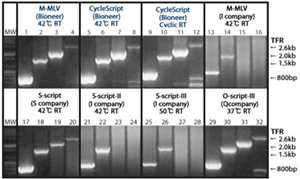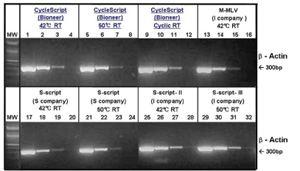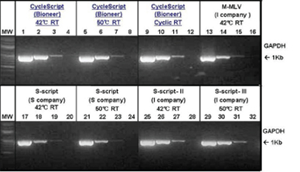For cDNA Synthesis and cDNA amplification
Get more cDNA in less time with
CycleScript Reverse Transcriptase.
CycleScript is a versatile reverse transcriptase - applicable to both conventional Reverse Transcription and Cyclic Reverse Transcription (Cyclic RT, patent pending – for cDNA amplification). It features high activity across a wide range of temperatures from 37 to 55°C therefore, reverse transcription is carried out like PCR. The Cyclic RT reaction is composed of the following steps: 1
st incubation at 15~40°C for primer annealing, heating up to 42~48°C for extension, and finally incubation at 50~55°C for denaturation of the secondary structure of the RNA (optional). Bioneer's novel Cyclic RT system offers homogeneous cDNA synthesis, with a high yield of cDNA up to 9 kb.
Features and Benefits
-
Broad range of working temperatures: For G:C rich RNAs or RNAs with significant secondary structure
-
Sensitive: Even the rarest transcript can be reliably made into cDNA
-
High yield of cDNA: For genes up to 9 kb within 10 minutes
-
RNase, DNase, and Proteinase-free: Ensures the integrity of your samples
Enzyme Properties
5' to 3' exonuclease activity: No
3' to 5' exonuclease activity: No
3’ – A Overhang: Yes
Strand Displacement: Yes
Fragment Size: Up to 9 kb
Application
First-strand synthesis of cDNA from RNA molecules
RT-PCR
Random priming reaction
Library construction
Probe labeling
mRNA 5’ end mapping by primer extension analysis
Reagents Supplied
5 x Reaction Buffer: 50 mM Tris-HCl, 250 mM KCl, 10 mM MgCl2, pH 8.1
100 mM DTT
dNTP Mix: 2.5 mM of each dNTP
Concentration
200 U/μl
Storage Conditions
50% glycerol containing 20 mM Tris-Cl (pH7.6), 150 mM NaCl, 0.1 mM EDTA, 1 mM DTT, 0.1 % IGEPAL CA-630
Store Temperature
-20°C
Unit Definition
One unit is defined as the amount of enzyme required to incorporates 1 nmole of dTTP into acid-precipitable material in 10 minutes at 37°C using poly (A)ooligo (dT) as template primer.

Figure 1. Comparison of transferrin receptor gene amplification with different reverse transcriptases.
700 ng of total RNA was used for reverse transcription and the same amount of amplified products were used for electrophoresis.
Lane MW: 100 bp Plus DNA Ladder (D-1035)
Lane 1 - 4: TFR (Transferrin receptor gene) amplified with MMLV
Lane 5 - 8: TFR amplified with CycleScript
Lane 9 - 12: TFR amplified with CycleScript
Lane 13 - 16: TFR amplified with MMLV from Company IA
Lane 17 - 20: TFR amplified with S-script from Company S
Lane 21 - 24: TFR amplified with S-script ll from Company I
Lane 25 - 28: TFR amplified with S-script lll from Company I
Lane 29 - 32: TFR amplified with O-script from Company Q

Figure 2. Comparison of β-actin gene amplification with different reverse transcriptases.
Each 10 ng, 1 ng, 100 pg, and 10 pg of total RNA was used for reverse transcription and the same amount of amplified products were used for electrophoresis.
Lane 1 - 4: &beta-actin amplified with CycleScript
Lane 5 - 8: &beta-actin amplified with CycleScript
Lane 9 - 12: &beta-actin amplified with CycleScript
Lane 13 - 16: &beta-actin amplified with MMLV from Company I
Lane 17 - 20: &beta-actin amplified with S-script from Company S
Lane 21 - 24: &beta-actin amplified with S-script from Company S
Lane 25 - 28: &beta-actin amplified with S-script from Company I
Lane 29 - 32: &beta-actin amplified with S-script from Company I

Figure 3. Comparison of GAPDH gene amplification with different reverse transcriptases.
Each 10 ng, 1 ng, 100 pg, and 10 pg of total RNA was used for reverse transcription and the same amount of amplified products were used for electrophoresis.
Lane 1 - 4: GAPDH amplified with CycleScript
Lane 5 - 8: GAPDH amplified with CycleScript
Lane 9 - 12: GAPDH amplified with CycleScript
Lane 13 - 16: GAPDH amplified with MMLV from Company I
Lane 17 - 20: GAPDH amplified with S-script from Company S
Lane 21 - 24: GAPDH amplified with S-script from Company S
Lane 25 - 28: GAPDH amplified with S-script from Company I
Lane 29 - 32: GAPDH amplified with S-script from Company I

Figure 4. Working temperature comparison of different reverse transcriptases.
Each 10 ng, 1 ng, 100 pg, and 10 pg of total RNA was used for reverse transcription and the same amount of amplified products were used for electrophoresis.
Lane 1 - 4: GAPDH amplified with CycleScript
Lane 5 - 8: GAPDH amplified with CycleScript
Lane 9 - 12: GAPDH amplified with CycleScript
Lane 13 - 16: GAPDH amplified with S-script from company S
Lane 17 - 20: GAPDH amplified with S-script from company S
Lane 21 - 24: GAPDH amplified with S-script from company S
|
Cat.No.
|
Product Description
|
Price
|
Add to Cart
|
| E-3131
|
CycleScript Reverse Transcriptase (10,000U, 50 rxn)
|
Inquire
|
|
| E-3132
|
CycleScript Reverse Transcriptase (50,000U, 250 rxn)
|
Inquire
|
|
| EB-1003
|
5X reaction buffer, 1 ml
|
Inquire
|
|